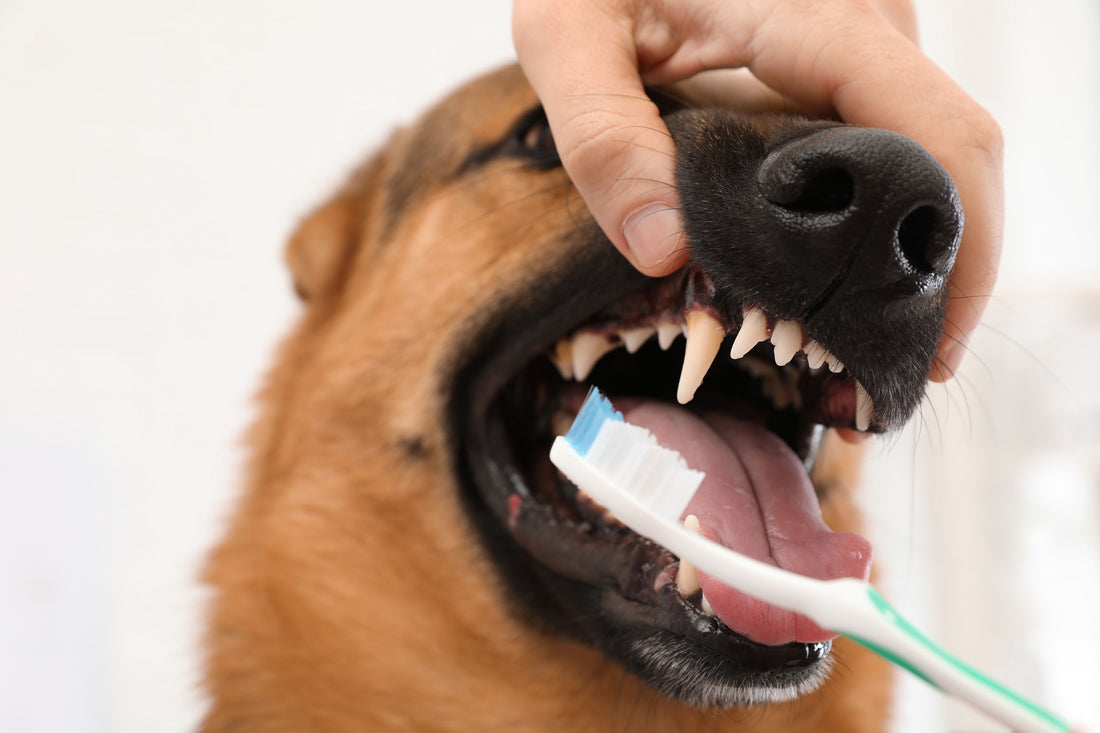
How to Brush Your Dog's Teeth in 5 Steps
Teeth. Those pearly whites. We may not think about them as often as we need to. And we need them to be healthy more than we realize.
They’re necessary for eating certain foods we enjoy, they’re a sense of personal pride, and if they’re not taken care of, they can be a source of pain and discomfort.
Well, the same goes for dogs too. Dogs need their teeth for chewing on their favorite toys and crunching their favorite foods. And while a dog may not care much about what his own teeth look like, we as pet parents may take a great deal of pride in those nice pearly whites.
And unfortunately, a dog’s teeth can definitely be a source of significant disease if not taken care of.
So, it makes sense to take care of them!
In this article, we’re going to briefly discuss why knowing how to brush a dog’s teeth is important, how often it may be necessary to brush, and last but not least, step-by-step tips to introduce your pup to brushing.

Brushing Teeth: Why Bother?
Periodontal Disease
Periodontal disease comprises a few factors, but essentially consists of the effects of the inflammatory response that the body creates to address bacterial plaque that builds up in the mouth.
When we or our pets eat food, there’s always little microscopic bits left behind. The bacteria in our mouths thrive on this, creating what’s called a biofilm, also called plaque. This is that slimy stuff you can feel on your teeth when you wake up in the morning.
Over time, plaque hardens into tartar, which can also be termed calculus. Our immune systems really dislike this bacterial biofilm and attack it, leading to inflammation in the form of gingivitis (gum inflammation) and periodontitis which affects the bones and tissue surrounding the teeth beneath the gums.
The severity of this is likely most related to what types of bacteria are present and how our immune systems react to them, which can be different for everybody.
Periodontal disease is a widespread problem. According to one 2016 article in PLoS One, the prevalence of periodontal disease in dogs may range from 44%-80%.
And it’s not just a problem in pets. According to the CDC, half of Americans aged 30 and over have periodontitis. Pretty similar figures.
Over time in people, periodontal disease leads to cavity formation from the acids present in plaque, severe tooth decay, and eventually loss of teeth.
In dogs, we don’t so much see actual cavities the way people get them. With dental disease in pups, the teeth themselves are often intact, but the tissues around them, including jaw bone gets degraded over time, abscesses and infections result, and teeth will eventually fall out.
We do actually see root degeneration and ulcerative lesions on teeth of dogs similar to cavities, but the process is likely different in dogs since they don’t eat food high in sugar, and is related more to the immune system attacking the teeth themselves.
Does Periodontal Disease Just Affect Teeth?
Periodontal disease can become severe if teeth aren’t taken care of, both in people and pets. The process causes significant oral pain and eventual loss of teeth. This should be reason enough to focus on dental care.
But for any out there who are in the camp of “well, if he’s eating he must be fine”, consider how much pets may hide signs of disease and discomfort. It’s ingrained in their nature to hide pain, so that they don’t look vulnerable to other animals.
And if you have a pup that never misses a meal and enjoys his food, think about how much pain he’d have to be in to actually stop eating. Most dogs and cats will adapt and find ways around the pain they feel until it’s severe.
But if oral pain and teeth loss isn’t enough to be concerning, there is mounting evidence about the effects on other parts of the body that periodontal disease can have. And this isn’t just in pets, but most definitely in people too.
According to Medical News Today, the incidence of people with heart-valve infections, termed endocarditis, has been increasing steadily for the last few decades. The principle of endocarditis as related to dental disease is simple. The inflammation and bleeding that occurs with gingivitis and periodontitis allows bacteria in the mouth to enter the blood stream, where they eventually set up shop on heart valves.
The bacterial plaques that form on heart valves lead to thickened and dysfunctional valves, causing secondary heart disease and even heart failure. And naturally, having bacteria living inside your heart raises a huge risk for body-wide septic infections and death.
While periodontal disease is not the only cause of endocarditis, it is considered to be one of the greatest risk factors.
In pets, periodontal disease is also considered to be a big risk factor for heart disease. After all, smaller breed dogs most often have the worst dental disease and also have the highest prevalence of heart disease. Development of heart disease is also related to genetics, but what if periodontal disease plays more of a part than was previously thought?
There are two recent studies that support this thought and are leading to increased concerns. One, from Research in Veterinary Science, was published just recently in the summer of 2019. It sought to review clinical records for over 100 dogs and look for patterns between the presence of periodontal disease and other concurrent diseases like heart disease, kidney disease, etc.
Main findings of this study included a higher risk factor for small breed dogs as well as a connection with the presence of heart disease. Dogs without dental disease, even small breed dogs, had a much lower incidence of heart-related issues.
A second study from PLoS One from 2016 investigated the presence of Enterococcus, a specific type of bacteria and its connection between presence in the mouth and presence on the heart valves of dogs with confirmed endocarditis on post-mortem exam.
Of 65 samples including oral swabs and heart valve samples , 35 cultured Enterococcus. And of the 13 positive samples found on heart valves, 7 had the same strain both in the heart and in the mouth.
The authors of this study concluded that there was an “unquestionable association” between periodontal disease and bacterial endocarditis in dogs.
So What Does This Mean for My Dog?
These studies and increased association that’s being seen between dental disease and heart disease in dogs really highlights the importance of regular dental care. And we’re not just talking about dental cleanings with your vet. We’re talking about routine care at home too.
While dental cleanings are important, as we’ll touch on at the end, having your or your dog’s teeth cleaned just once a year isn’t going to replace constant removal of the bacterial biofilm that builds up everyday. Only regular brushing combined with dental treats can do that.

How Often Do I Need to Clean My Dog’s Teeth?
It’s a great question, and a pretty simple one to answer: every day.
Think about dental recommendations for yourself. The American Dental Association recommends brushing your teeth twice a day, after each meal. Want to brush after lunch too? Even better.
Is brushing twice a day for pup parents practical though? Probably not for most, especially in the morning trying to get ready for work, getting the kids off to school, etc. But we could argue that once a day is manageable, especially as an evening routine. Maybe we replace that morning brushing with a dental treat or chew.
But I know plenty of you out there are going to say that even daily brushing is impractical. Some dogs don’t like it and it can be a struggle. How am I supposed to do that every day?
So then you ask, what’s the absolute minimum frequency for brushing that will still provide some benefit. My answer is 2-3 times per week. This frequency should at least help remove most plaque before it has the ability to form into tartar.
What about once every couple of weeks? I have some pet parents that do this, but I don’t really see how such a low frequency can really help, and it doesn’t seem to, based on annual exams of these pets’ teeth.
If your pooch is good for teeth brushing, do it more often because it’s going to help more. If she’s not good for brushing and it’s a struggle to just do it that infrequently, it might be better to turn to other methods of addressing dental health.
Why is such infrequent brushing not that helpful? Well, if given enough time, the daily build-up of plaque will form into tartar or calculus. Once calculus forms, it can’t be brushed off. I’ve occasionally had requests from well-meaning pet parents that, on top of getting a nail trim done, would like us to brush their pup’s teeth.
I’ll do it, because the client has asked and it won’t hurt, but when you brush teeth with heavy tartar build-up and see a pup’s inflamed gums get more irritated, you have to ask yourself what that’s accomplishing, especially if the tartar isn’t coming off.
So essentially, aim for 2-3 times a week, and if you can do it more often, actually do it more often.
How to Brush a Dog’s Teeth
Now, as promised we’ll go over some step-by-step guidelines for getting your pup acclimated to teeth brushing.
As with any basic thing we expect our pups to be able to tolerate well, like nails, grooming, etc., it’s important to start teeth brushing habits at the youngest age when a pooch is just a young puppy.
I always advise my clients with new puppies to start working on brushing at 8 weeks of age. It’s true they’ll lose their baby teeth in just a couple months, but it’s going to be much harder to train your puppy to do this when he’s several months old. And if you try after 1 year of age or even later when you start to actually notice tartar build-up, you’ll wish you had started much earlier.
But even if you have an older pup, it doesn’t hurt to try. Use these steps for a slow introduction to brushing, regardless of how young or old your pup is.
And always remember throughout these steps to make this as positive an experience as possible by providing small treat rewards frequently and to use lots of praise when you successfully complete a step.
And don’t try to do too much at once. If you make it through one step, or even half of one step and it starts to turn into a struggle, give it a rest and take things up again when your pup is calm and rested.
Step 1: Get Your Pup Used to His Mouth Being Handled
This may be the hardest step. Puppies want nothing more than to chew and bite your hand, and adult pups can’t figure out what the heck you’re trying to do.
But start with the basics by lifting your pup’s lips up to expose his teeth. If this is all he lets you do before running off, stop there for now and repeat this very simple part of the step until he becomes comfortable with it.
If this part goes easily, move into inserting your finger along his teeth, progressing back towards the large premolars. These back teeth often hide the worst dental tartar buildup, so it’s important to be able to reach these areas.
Work on this for a couple days, a week, or however long it takes until your pup becomes comfortable with sitting still to let you do it. And make sure to always use positive rewards like treats or praise.
Step 2: Get Your Pup Used to Toothpaste
First, it’s REALLY important not to use fluoride toothpaste with your pets. Pets have an increased sensitivity to fluoride. You need to use a toothpaste designed for dogs.
C.E.T Home Care dental products made by Virbac is one of the most common types you’ll see. But regardless of brand, all toothpastes should be free of fluoride and are made with flavors more enticing to pets, like liver, fish, or poultry flavors. Can you imagine trying a mint or bubble gum-flavored toothpaste for your pup? Some pooches of course will eat anything, but many wouldn’t like our favorite toothpaste flavors.
Put a little toothpaste on your finger and let your pup lick it off, kind of like a treat. And in fact, as long as she likes the flavor, you can use it as a treat incentive while you continue to work on lifting her lips and inserting your finger along the gumline and teeth.
Step 3: Combine Toothpaste and Finger
The next thing we want to do is bring our toothpaste flavor and our finger together, to start simulating brushing motions.
It’s really important with brushing motions in dogs to not be really forceful or intense. When you watch some people brush their teeth, you’d think they’re in some kind of frenzy with how quick and aggressive they make brushing motions. Don’t do this with your pup.
With some toothpaste on your finger, work on slow, gentle swirling motions, starting near the gumline and coming down towards the teeth. We don’t need vigorous back and forth motions. In time, you might be able to increase your speed, but starting out slow will make it more agreeable for your pup.
Step 4: Introduce a Brush
There are a few styles of toothbrush out there that can be used for dogs. The first looks a lot like a conventional brush, but often has a longer handle to accommodate our long-snouted friends. This is the most common type you might find at the pet store or from your veterinarian.
The second is a finger brush. This is essentially a little plastic sleeve that fits over your finger and has a small cluster of bristles on the end. I find that the finger brush may be the most natural transition from your bare finger to a brush.
The third type of brush you can use is a human toddler’s small, soft brush. This may only work best for small breed dogs, but its small size and short handle may be better tolerated and less awkward.
Regardless of which brush you choose, insert the brush and work on your gentle motions. You don’t have to add the toothpaste yet if you don’t want to, but make sure to still use it as a treat incentive to keep it a part of the process.
Step 5: Bring It All Together
Now you’re going to combine your brush, toothpaste, and motions, all in one. Put a little toothpaste on the brush and work on those gentle swirling motions, working your way from the front incisors, past the canines, and back to the premolars and molars.
Tips for Brushing
As I said, I feel that the finger brush may be the most natural transition from finger to brush. If you find your pup doesn’t mind an actual hand-held brush, go for it. But if introducing this tool seems awkward, or if your pup was fine with your finger but not with an actual brush, try the finger brush instead.
At any point or step, if your pooch puts on the breaks, don’t press the attack. Stay at the last tolerated step for longer and then try again. And remember to always keep it positive.
How long should you work on each step for? It’s dependent on each dog and how they tolerate each step, but I generally recommend working on each step for at least 5-7 days to have a nice slow and tolerated transition.
Are There Alternatives to Brushing?
So you’ve given it a good old college try, but your pup just won’t go for it. What else can you do?
There are a couple other ways to help provide dental health care at home. Though they are not as effective as brushing, they are better than doing nothing at all.
Dental Treats
Dental treats are the second best way to provide home dental care. These treats have actually become quite sophisticated in design to help scrape and wear the plaque off dogs' teeth.
But while daily use is important, always remember that dental treats do contain calories and should be no more than 10% of the daily diet, including any other treats your pup gets.
Not all dental treats are considered equal. The Veterinary Oral Health Council is an impartial body that has a list of treats and other products that have shown actual clinical reduction in tartar build-up.
Water Additives
Water additives are probably the least effective method of dental health, but is better than nothing. The principle is that antiseptic ingredients, kind of like what is found in human mouthwash (but without fluoride) will kill bacteria in the mouth every time your dog drinks from the bowl you’ve added it to.
Very few of these products have shown clinical proof of efficacy, but the VOHC does have a couple included in their list, also to be found in the link above.
Dental Wipes
If your pup doesn’t mind your finger being in her mouth, but hates the idea of toothpaste or the brush, you might consider dental wipes. You essentially use these to wipe your dog’s teeth to remove that nasty biofilm of plaque. This does at least help to reduce bacteria build-up on teeth.
There are many brands of dog wipes out there, but only one has the VOHC endorsement of efficacy, which you can find with that same VOHC link.
So If I Can Brush My Dog’s Teeth, Why is a Dental Cleaning Necessary?
We won’t get into dental procedures very much, since that’s a whole topic for another article, but many pet parents may justifiably ask this question.
But this question isn’t too hard to answer if you think about your own dental health. Even if you brush twice a day and floss on top of that and use mouthwash, you’re still going to have plaque and tartar build-up.
This is why dental checks and cleanings are recommended at least yearly by the American Dental Association. And if you have a history of periodontal disease, they recommend them more frequently.
Both our teeth and those of our pets have small grooves and cusps that are great at trapping food material and providing a shelter for plaque and bacteria to fester. Plaque also builds up underneath the gumline. Most toothbrushes have a limited ability to get under the gumline well-enough or to reach these hard-to-get spaces.
The same is true for dogs. The back premolars and molars especially have small crevices that are hard to get to. So even if you brush everyday, you’ll find the need for a dental cleaning for your pup at some point, though possibly much less frequently than with a pooch who doesn’t have any home dental care.
Not Sure What Your Dog’s Teeth Look Like? Ask Your Vet!
Veterinarians are part dentists. It’s true. We know a lot about oral health in pets and how to make appropriate recommendations.
So if you’re not sure if your pup’s teeth are healthy or if an actual dental cleaning is needed, make sure to bring it up at your furry friend’s next exam.
Your vet will be the best one to discuss a dental cleaning with, especially since he or she will be the one to perform it. It’s true that dental cleanings are performed under anesthesia and this does pose risks, but there are risks to leaving dental disease to fester too.
Your veterinarian’s job is to weigh the risks and benefits of a dental cleaning with other health risks your pup may be facing and to help you make the best and most informed decision. Sometimes, we do decide that a dental procedure is too risky based on other health concerns.
But because we don’t know what health risks our pets may encounter in the future, it makes home dental care and good prevention from the earliest time all the more important.







